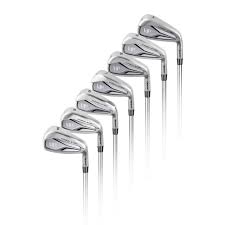Mastering Your Game with Precision: A Guide to Golf Irons

The Essential Guide to Golf Irons
Golf irons are a crucial part of any golfer’s equipment arsenal. These clubs are versatile and indispensable for various shots on the course, from tee-offs to approach shots. Understanding the different types of irons and their characteristics can greatly improve your game.
Types of Irons
There are typically three main types of irons: long irons (2-4), mid-irons (5-7), and short irons (8-PW). Long irons have lower lofts and are designed for longer distances, making them ideal for tee shots or hitting the ball from the fairway. Mid-irons offer a balance between distance and loft, while short irons have higher lofts for precision shots near the green.
Features of Irons
Irons come in various designs, including cavity-back, muscle-back, and hollow-body constructions. Cavity-back irons have weight distributed around the perimeter, providing forgiveness on off-center hits. Muscle-back irons have more weight concentrated behind the clubface, offering better control and feedback. Hollow-body irons combine the forgiveness of cavity-backs with the feel of muscle-backs.
Choosing the Right Irons
When selecting irons, consider your skill level, playing style, and preferences. Beginners may benefit from cavity-back irons for forgiveness, while advanced players might prefer muscle-back or blade irons for greater control. It’s essential to test different clubs to find ones that suit your game best.
Caring for Your Irons
To maintain your irons’ performance, regularly clean them after each round to remove dirt and debris. Check the clubfaces for wear and tear, as worn grooves can affect spin and distance control. Store your irons in a dry place to prevent rusting and consider regripping them periodically for optimal grip traction.
Conclusion
Golf irons play a vital role in shaping your performance on the course. By understanding the types of irons available, their features, and how to choose the right ones for your game, you can enhance your skills and enjoy a more rewarding golfing experience.
Essential Tips for Maintaining and Using Your Iron Safely and Effectively
- Always check the iron’s temperature settings before using it on different types of fabrics.
- Empty the water reservoir after each use to prevent mineral build-up and potential damage to the iron.
- Use distilled water in your iron to avoid mineral deposits that can clog the steam vents.
- Clean the soleplate regularly with a damp cloth and mild detergent to remove any built-up residue or stains.
- Store your iron in a safe place, ensuring that the cord is not twisted or damaged.
Always check the iron’s temperature settings before using it on different types of fabrics.
It is essential to always check the iron’s temperature settings before using it on different types of fabrics. Setting the iron to the appropriate temperature ensures that you avoid damaging delicate fabrics or scorching heavier materials. By taking a moment to adjust the temperature according to the fabric being ironed, you can achieve optimal results while prolonging the lifespan of your clothes.
Empty the water reservoir after each use to prevent mineral build-up and potential damage to the iron.
It is essential to empty the water reservoir of your iron after each use to prevent mineral build-up and potential damage. By regularly emptying the reservoir, you can avoid the accumulation of minerals from tap water, which can clog the steam vents and affect the iron’s performance over time. Additionally, emptying the reservoir helps maintain the iron’s longevity and ensures that it continues to function effectively for smooth and wrinkle-free ironing sessions.
Use distilled water in your iron to avoid mineral deposits that can clog the steam vents.
Using distilled water in your iron is a smart tip to prevent mineral deposits from accumulating and potentially clogging the steam vents. Distilled water lacks the minerals found in tap water, which can build up over time and affect the iron’s performance. By incorporating this simple practice into your iron maintenance routine, you can ensure that your iron operates efficiently and effectively, prolonging its lifespan and maintaining optimal steam output for wrinkle-free clothes.
Clean the soleplate regularly with a damp cloth and mild detergent to remove any built-up residue or stains.
It is essential to maintain the soleplate of your irons by cleaning it regularly with a damp cloth and mild detergent. This simple practice helps remove any accumulated residue or stains, ensuring that your irons perform optimally during each swing. By keeping the soleplate clean, you can preserve the club’s effectiveness and longevity, allowing you to focus on improving your game without any hindrances.
Store your iron in a safe place, ensuring that the cord is not twisted or damaged.
It is essential to store your iron in a secure location to maintain its condition and performance. Ensure that the cord is carefully placed without any twisting or damage. By storing your iron properly, you can prolong its lifespan and prevent any potential issues that may arise from mishandling or neglect. Taking care of the cord ensures that your iron remains in optimal working condition whenever you need it for your golfing sessions.

